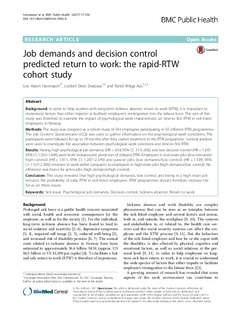| dc.contributor.author | Haveraaen, Lise | |
| dc.contributor.author | Skarpaas, Lisebet Skeie | |
| dc.contributor.author | Aas, Randi Wågø | |
| dc.date.accessioned | 2017-03-17T09:23:33Z | |
| dc.date.available | 2017-03-17T09:23:33Z | |
| dc.date.created | 2016-12-16T11:11:06Z | |
| dc.date.issued | 2017-02 | |
| dc.identifier.citation | Haveraaen, L. A., Skarpaas, L.S., Aas, R.W., (2017) Job demands and decision control predicted return to work: the rapid-RTW cohort study. BMC Public Health, 17:154 | nb_NO |
| dc.identifier.issn | 1471-2458 | |
| dc.identifier.uri | http://hdl.handle.net/11250/2434476 | |
| dc.description.abstract | Background:
In order to help workers with long-term sickness absence return to work (RTW), it is important to understand factors that either impede or facilitate employee’s reintegration into the labour force. The aim of this study was therefore to examine the impact of psychological work characteristics on time-to first RTW in sick listed employees in Norway.
Methods:
The study was designed as a cohort study of 543 employees participating in 50 different RTW programmes. The Job Content Questionnaire (JCQ) was used to gather information on the psychological work conditions. The participants were followed for up to 18 months after they started treatment in the RTW programme. Survival analyses were used to investigate the association between psychological work conditions and time-to first RTW.
Results:
Having high psychological job demands (HR = .654; 95% CI: .513–.832) and low decision control (HR = 1.297; 95% CI: 1.010–1.666) were both independent predictors of delayed RTW. Employees in low-strain jobs (low demands/high control) (HR = 1.811; 95% CI: 1.287–2.549) and passive jobs (low demands/low control) (HR = 1.599; 95% CI: 1.107–2.309), returned to work earlier compared to employees in high-strain jobs (high demands/low control). No difference was found for active jobs (high demands/high control).
Conclusion:
This study revealed that high psychological demands, low control, and being in a high strain job reduced the probability of early RTW in sick listed employees. RTW programmes should therefore increase the focus on these issues. | nb_NO |
| dc.language.iso | eng | nb_NO |
| dc.publisher | BioMed Central | nb_NO |
| dc.rights | Navngivelse 4.0 Internasjonal | * |
| dc.rights.uri | http://creativecommons.org/licenses/by/4.0/deed.no | * |
| dc.subject | sykefravær | nb_NO |
| dc.subject | sykemeldinger | nb_NO |
| dc.subject | tilbake til jobb | nb_NO |
| dc.subject | sick leave | nb_NO |
| dc.subject | psychological job demands | nb_NO |
| dc.subject | decision control | nb_NO |
| dc.subject | sickness absence | nb_NO |
| dc.subject | return to work | nb_NO |
| dc.title | Job demands and decision control predicted return to work: the rapid-RTW cohort study | nb_NO |
| dc.type | Journal article | nb_NO |
| dc.type | Peer reviewed | nb_NO |
| dc.rights.holder | © The Author(s). | nb_NO |
| dc.subject.nsi | VDP::Medisinske Fag: 700::Helsefag: 800::Yrkesmedisin: 809 | nb_NO |
| dc.source.volume | 17 | nb_NO |
| dc.source.journal | BMC Public Health | nb_NO |
| dc.source.issue | 154 | nb_NO |
| dc.identifier.doi | 10.1186/s12889-016-3942-8 | |
| dc.identifier.cristin | 1413883 | |
| cristin.unitcode | 217,7,2,0 | |
| cristin.unitname | Institutt for helsefag | |
| cristin.ispublished | false | |
| cristin.fulltext | original | |
| cristin.qualitycode | 1 | |

